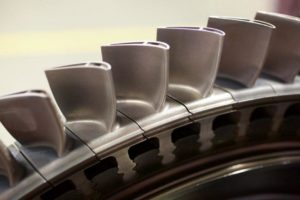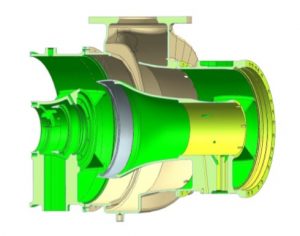 German engineering group Siemens is on a roll in its quest to determine just how many benefits can be offered by 3D printing in the power generation industry. The company completed the first full-load engine tests for its 3D printed gas turbine blades last year, only a few weeks before completing the first commercial installation of a 3D printed part in a nuclear power plant. Earlier this year, it had 3D printed and installed its first industrial steam turbine replacement part into customer equipment, and as of this April, Siemens had over two handfuls of 3D printed gas turbine components qualified and released for serial production.
German engineering group Siemens is on a roll in its quest to determine just how many benefits can be offered by 3D printing in the power generation industry. The company completed the first full-load engine tests for its 3D printed gas turbine blades last year, only a few weeks before completing the first commercial installation of a 3D printed part in a nuclear power plant. Earlier this year, it had 3D printed and installed its first industrial steam turbine replacement part into customer equipment, and as of this April, Siemens had over two handfuls of 3D printed gas turbine components qualified and released for serial production.
Now, the company has hit another milestone – Siemens announced that it has 3D printed and engine tested a dry low emission (DLE) pre-mixer for its industrial SGT-A05 aeroderivative gas turbine; 3D printing was also used to improve aerodynamic development testing for this particular turbine last month.
The results of this 3D printed combustion component show that it could help significantly lower CO emissions, and numerous other achievements have also resulted from using 3D printing to fabricate this specific component. Complexity in the production process is simplified, and the geometry of the component was improved upon, which led to a better fuel-air mix. In addition, 3D printing the DLE pre-mixer helped to decrease external dependencies in the supply chain.“This is another excellent example of how additive manufacturing is revolutionizing our industry, delivering measurable benefits and real value to our customers, particularly as they look to further reduce emissions to meet environmental target. Our achievements using AM are paving the way for greater agility in the design, manufacturing and maintenance of power generation components,” said Vladimir Navrotsky, Chief Technology Officer for Siemens Power Generation Services, Distributed Generation.
First, the development of the component only took seven months from start to finish – this is a pretty impressive timeframe for a complex, high-temperature component with tight tolerances that works with high loads. When made with traditional manufacturing processes, the DLE pre-mixer has over 20 parts, but this was reduced down to only two parts by 3D printing the component out of Siemens’ qualified nickel super alloys; this also helped lower the lead time by about 70%.
 Siemens recently completed the first engine testing of the 3D printed component, which shows some promising data. The test revealed that there were no combustion dynamics or noise, no start issues, and that all of the fuel transitions were completed without needing any controls modifications. In addition, full power was achieved and there was a measurable reduction in CO emissions.
Siemens recently completed the first engine testing of the 3D printed component, which shows some promising data. The test revealed that there were no combustion dynamics or noise, no start issues, and that all of the fuel transitions were completed without needing any controls modifications. In addition, full power was achieved and there was a measurable reduction in CO emissions.
Douglas Willham, Siemens Director of Engineering for the SGT-A05, said, “And now, with AM technology we have an opportunity to go even further with emissions reduction for DLE combustion.”
The 3D printed DLE solution for Siemens’ SGT-A05 gas turbine uses advanced lean burn combustion technology to reduce emissions, which meant that water injection was not needed; this also helps lower costs. The engine model’s high dynamic loading response is not compromised by applying DLE, evidenced by the fact that over 120 engines successfully use the technology to lower CO and NOx emissions.
The DLE pre-mixer was 3D printed at Siemens’ AM Center of Competence in Sweden. These positive test results further show how committed the company is to moving forward 3D printed serial production of highly complex components in the energy industry.
Discuss this story and other 3D printing topics at 3DPrintBoard.com or share your thoughts in the Facebook comments below.
[Source: Power]Subscribe to Our Email Newsletter
Stay up-to-date on all the latest news from the 3D printing industry and receive information and offers from third party vendors.
Print Services
Upload your 3D Models and get them printed quickly and efficiently.
You May Also Like
The Dental Additive Manufacturing Market Could Nearly Double by 2033, According to AM Research
According to an AM Research report from 2024, the medical device industry, specifically in dentistry, prosthetics, and audiology, is expected to see significant growth as these segments continue to benefit from...
Heating Up: 3D Systems’ Scott Green Discusses 3D Printing’s Potential in the Data Center Industry
The relentless rise of NVIDIA, the steadily increasing pledges of major private and public investments in national infrastructure projects around the world, and the general cultural obsession with AI have...
AM Research Webinar Explores Continuum’s Sustainable Metal Additive Manufacturing Powders
Metal additive manufacturing (AM) powder supplier Continuum Powders is working to develop solutions that empower industries to reduce waste and optimize their resources. An independent life cycle assessment (LCA) of...
3D Printed Footwear Startup Koobz Lands $7.2M in Seed Round
California-based Koobz is focused on reshoring the U.S. footwear supply chain with advanced manufacturing processes, including 3D printing. The startup just announced that it has added $6 million to its...

































